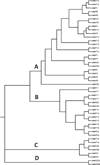Update of human and mouse matrix metalloproteinase families
- PMID: 20368140
- PMCID: PMC3525976
- DOI: 10.1186/1479-7364-4-3-194
Update of human and mouse matrix metalloproteinase families
Abstract
Matrix metalloproteinases (MMPs) are a family of zinc proteases that degrade most of the components of the extracellular matrix (ECM). MMPs also have a number of non-traditional roles in processing factors related to cell growth/proliferation, inflammation and more. There are 23 human MMPs and 23 mouse MMPs, most of which share orthology among most vertebrates; other examples have been found in invertebrates and plants. MMPs are named in order of discovery, but also have been grouped by domain structure or by phylogenetic analysis. MMPs are multi-domain proteins which generally contain a signal sequence; propeptide (which keeps the protein inactive until cleaved); catalytic domain; and a hemopexin-like domain (which provides substrate specificity). MMPs are thought to play a role in many disease states, including arthritis, vascular disease, lung injury, wound repair, cancer and various neurodegenerative disorders. Although there has been much clinical interest in MMP inhibitors (MMPIs), few trials have been successful - often due to the broad nature of inhibition and the complex role of different MMPs in a given disease state.
Figures


Similar articles
-
Biochemical and Biological Attributes of Matrix Metalloproteinases.Prog Mol Biol Transl Sci. 2017;147:1-73. doi: 10.1016/bs.pmbts.2017.02.005. Epub 2017 Mar 22. Prog Mol Biol Transl Sci. 2017. PMID: 28413025 Free PMC article. Review.
-
Matrix Metalloproteinases, Vascular Remodeling, and Vascular Disease.Adv Pharmacol. 2018;81:241-330. doi: 10.1016/bs.apha.2017.08.002. Epub 2017 Sep 19. Adv Pharmacol. 2018. PMID: 29310800 Free PMC article. Review.
-
Structure and evolutionary aspects of matrix metalloproteinases: a brief overview.Mol Cell Biochem. 2003 Nov;253(1-2):31-40. doi: 10.1023/a:1026093016148. Mol Cell Biochem. 2003. PMID: 14619953 Review.
-
Next generation matrix metalloproteinase inhibitors - Novel strategies bring new prospects.Biochim Biophys Acta Mol Cell Res. 2017 Nov;1864(11 Pt A):1927-1939. doi: 10.1016/j.bbamcr.2017.06.009. Epub 2017 Jun 19. Biochim Biophys Acta Mol Cell Res. 2017. PMID: 28636874 Review.
-
Molecular Imaging Probes Based on Matrix Metalloproteinase Inhibitors (MMPIs).Molecules. 2019 Aug 16;24(16):2982. doi: 10.3390/molecules24162982. Molecules. 2019. PMID: 31426440 Free PMC article. Review.
Cited by
-
In-vitro and in-vivo imaging of MMP activity in cartilage and joint injury.Biochem Biophys Res Commun. 2015 May 8;460(3):741-6. doi: 10.1016/j.bbrc.2015.03.100. Epub 2015 Mar 26. Biochem Biophys Res Commun. 2015. PMID: 25817731 Free PMC article.
-
Integrative proteome and metabolome analyses reveal molecular basis of the tail resorption during the metamorphic climax of Nanorana pleskei.Front Cell Dev Biol. 2024 Aug 19;12:1431173. doi: 10.3389/fcell.2024.1431173. eCollection 2024. Front Cell Dev Biol. 2024. PMID: 39224435 Free PMC article.
-
Ultrasensitive tumour-penetrating nanosensors of protease activity.Nat Biomed Eng. 2017;1:0054. doi: 10.1038/s41551-017-0054. Epub 2017 Apr 10. Nat Biomed Eng. 2017. PMID: 28970963 Free PMC article.
-
TLR9 Deficiency in B Cells Promotes Immune Tolerance via Interleukin-10 in a Type 1 Diabetes Mouse Model.Diabetes. 2021 Feb;70(2):504-515. doi: 10.2337/db20-0373. Epub 2020 Nov 5. Diabetes. 2021. PMID: 33154070 Free PMC article.
-
Unravelling the molecular tapestry of pterygium: insights into genes for diagnostic and therapeutic innovations.Eye (Lond). 2024 Oct;38(15):2880-2887. doi: 10.1038/s41433-024-03186-y. Epub 2024 Jun 21. Eye (Lond). 2024. PMID: 38907016 Review.
References
-
- Nagase H, Barrett AJ, Woessner JF Jr. 'Nomenclature and glossary of the matrix metalloproteinases'. Matrix Suppl. 1992;1:421–424. - PubMed
Publication types
MeSH terms
Substances
Grants and funding
LinkOut - more resources
Full Text Sources
Other Literature Sources

